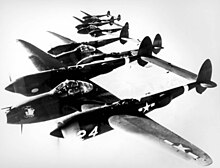332d Fighter-Interceptor Squadron
| 332d Fighter-Interceptor Squadron | |
|---|---|
F-102A Delta Dagger<rev group=note>Aircraft is Convair F-102A-75-CO Delta Dagger, serial 56-1329, taken at McGuire AFB. | |
| Active | 1942–1944; 1953–1965 |
| Country | |
| Branch | |
| Role | Fighter-Interceptor |
| Engagements |
|
| Decorations |
|
| Insignia | |
| Patch with 332d Fighter-Interceptor Squadron emblem (approved 29 February 1956)[1] |  |
| 332d Fighter Squadron emblem (World War II) |  |
The 332d Fighter-Interceptor Squadron is an inactive
Thule Air Base, Greenland
, where it was inactivated on 31 May 1965.
The squadron was first organized during
air defense
organization. It moved to Greenland in 1960.
History
World War II

The
In September 1942 the 329th Group
Army Air Forces (AAF) reorganization in which units not programmed to deploy overseas were replaced by AAF Base Units in order to free up manpower for overseas assignment because standard military units, based on relatively inflexible tables of organization were not proving well adapted to the training mission. Accordingly, a more functional system was adopted in which each AAF base was organized into a separate numbered unit.[6]
Cold war air defense
The squadron was reconstituted, redesignated the 332d Fighter-Interceptor Squadron and activated at
Air Defense Command's Project Arrow, which was designed to bring back on the active list the fighter units which had compiled memorable records in the two world wars.[1][9][10]

Project Arrow did not see the end of the 332d. Instead, it moved on paper to
4621st Air Defense Wing (SAGE) was organized at McGuire in the Spring of 1956 and attached to the 4709th Wing until the 4621st Wing assumed the mission of the 4709th wing in October 1956.[11] As SAGE became operational, the squadron upgraded its Sabres to the F-86L model, which was equipped with data link for interception control through the SAGE system.[8]
In July 1959, the squadron moved to
Thule Air Base, Greenland,[1] where it resumed the air defense mission that had been carried out at Thule until March 1960 by the 327th Fighter-Interceptor Squadron.[12] The squadron was inactivated in 1965, when the air defense mission at Thule became one of surveillance.[8]
Lineage
- Constituted as the 332d Fighter Squadron (Twin Engine) on 24 June 1942
- Activated on 10 July 1942
- Disbanded on 31 March 1944
- Reconstituted and redesignated 332d Fighter-Interceptor Squadron on 11 February 1953
Assignments
|
|
Stations
|
|
Aircraft
|
|
References
- Notes
- Suffolk County Air Force Baseto join its World War II headquarters in another Project Arrow move. Maurer, Combat Squadrons, 14.
- Citations
- ^ a b c d e f g h i Maurer, Combat Squadrons, p. 410
- ^ a b c Maurer, Combat Units, p. 210
- ^ Craven & Cate, Introduction, p. xxxvi
- ^ "Abstract, History 329 Fighter Group, Activation-Dec 1943". Air Force History Index. Retrieved 30 May 2012.
- ^ Maurer, Combat Squadrons, p. 417
- ^ Goss, p. 75
- ^ Cornett & Johnson, p.121
- ^ a b c d e f g Cornett & Johnson, p.127
- ^ Buss, Sturm, Volan, & McMullen, p.6
- ^ Maurer, Combat Squadrons, pp. 323–324
- ^ Cornett & Johnson, p. 66
- ^ Maurer, Combat Squadrons, pp. 403–404
- ^ a b c d Lineage, including assignments, aircraft and stations, through 1963 in Maurer, Combat Squadrons, p. 410
Bibliography
![]() This article incorporates public domain material from the Air Force Historical Research Agency
This article incorporates public domain material from the Air Force Historical Research Agency
- Cornett, Lloyd H; Johnson, Mildred W (1980). A Handbook of Aerospace Defense Organization, 1946–1980 (PDF). Peterson AFB, CO: Office of History, Aerospace Defense Center. Archived from the original (PDF) on 13 February 2016. Retrieved 23 March 2012.
- Craven, Wesley F.; Cate, James L., eds. (1955). The Army Air Forces in World War II (PDF). Vol. VI, Men & Planes. Chicago, Illinois: University of Chicago Press. OCLC 704158. Retrieved 17 December 2016.
- Goss, William A (1955). "The Organization and its Responsibilities, Chapter 2 The AAF". In Craven, Wesley F; Cate, James L (eds.). The Army Air Forces in World War II. Vol. VI, Men & Planes. Chicago, Illinois: University of Chicago Press. p. 75. LCCN 48-3657.
- Goss, William A (1955). "The Organization and its Responsibilities, Chapter 2 The AAF". In Craven, Wesley F; Cate, James L (eds.). The Army Air Forces in World War II. Vol. VI, Men & Planes. Chicago, Illinois: University of Chicago Press. p. 75.
- Maurer, Maurer, ed. (1983) [1961]. Air Force Combat Units of World War II (PDF) (reprint ed.). Washington, DC: Office of Air Force History. LCCN 61060979. Retrieved 17 December 2016.
- Maurer, Maurer, ed. (1982) [1969]. Combat Squadrons of the Air Force, World War II (PDF) (reprint ed.). Washington, DC: Office of Air Force History. OCLC 72556. Retrieved 17 December 2016.
- Buss, Lydus H.(ed), Sturm, Thomas A., Volan, Denys, and McMullen, Richard F., History of Continental Air Defense Command and Air Defense Command July to December 1955, Directorate of Historical Services, Air Defense Command, Ent AFB, CO, (1956)
- "ADCOM's Fighter Interceptor Squadrons". The Interceptor. 21 (1). Aerospace Defense Command: 5–11, 26–31, 40–45, 54–59. January 1979.


